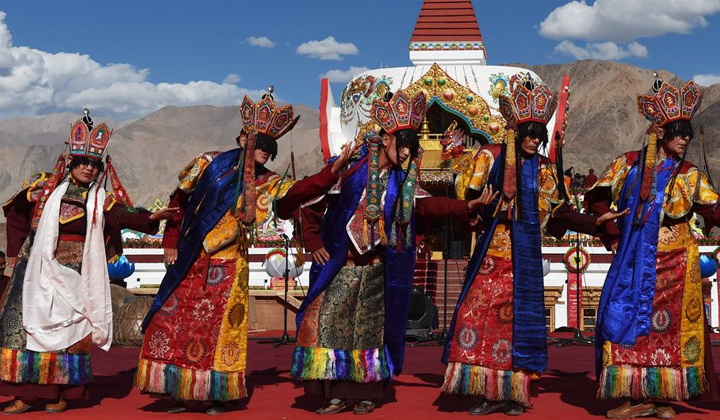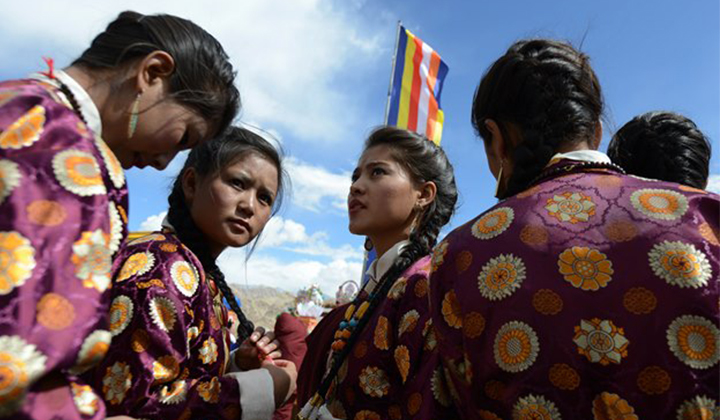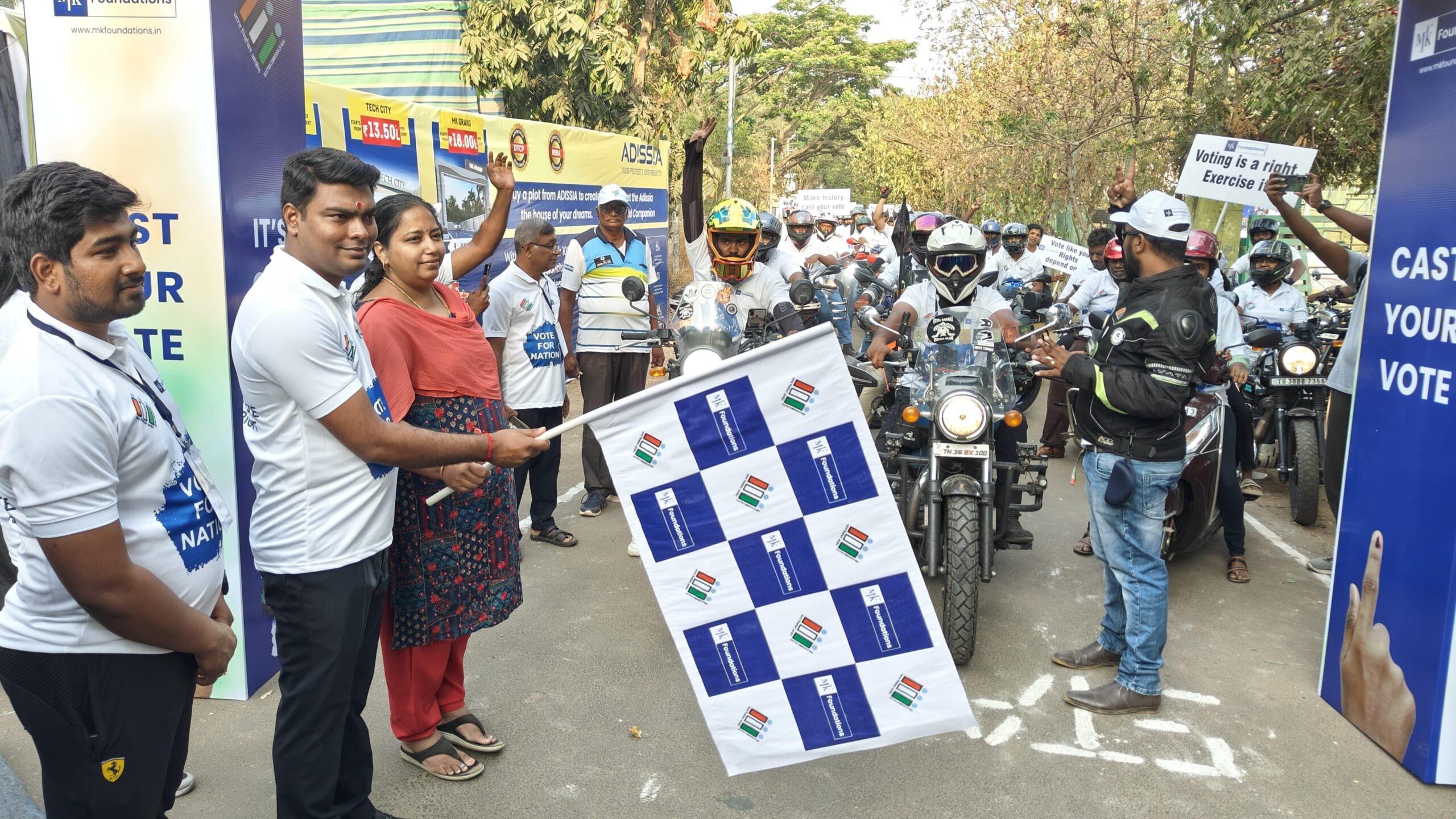Trending Now
- IPL 2024 begins with a bang. First contest between CSK and RCB.
- Election commission allots mike symbol to Naam Thamizhar Katchi
- AIADMK promises to urge for AIIMS in Coimbatore, in its election manifesto.
- Ponmudi becomes higher education minister.
Columns
Bollywood was the biggest draw for young Buddhists at the Kumbh of the Himalayas
![]() September 22, 2016
September 22, 2016
The Naropa Festival in Leh, held once every 12 years, tried to attract youngsters with an unusual feature.
Outside the Kushok Bakula Rinpoche Airport at Leh, billboards announced the Naropa Festival, described to outsiders as the Kumbh Mela of the Himalayas.
The Naropa festival this 2016 was particularly special for two reasons: it was the millennial birth anniversary of yogi Naropa of Drupka lineage, the leading sect of Himalayan Buddhism, and it coincided with the Hemis Festival, a celebration that marks the birth of Padmasambhava, the founder of Tibetan Buddhism.
Usually, Hemis is held in July, inside the monastery, the seat of Drupka order in Ladakh. It is better known among tourists for the famous and sacred Chams, the masked dance of the Lamas that is performed to the music of drums, long horns and cymbals.
In honour of the double celebration this year, a new Gompa (a religious structure, like a university) was built in Leh. Unfortunately, it could not be completed in time, and so the month-long ceremonies of Hemis and Naropa were squeezed into September, before the weather grew too cold.
Looking at the vast crowd that chose to stay in Leh despite the chill to celebrate, I realised why Naroda is called the Kumbh of the Himalayas: monks and nuns had gathered from Bhutan and Nepal, where Drupka sect following is large, but followers of Buddhism also arrived from Singapore, Malaysia, Vietnam, Sri Lanka, and the remote villages of Ladakh. From afar, the festival’s pandal area looks like a sea of maroon caps.
The biggest Buddhist festival in the world has changed in many ways over the years: for the convenience of global pilgrims, it has embraced technology. This year, the sacred ceremonies were held outside the new Gompa, where they were relayed on LED screens for the convenience of the large gathering.
Every day, the two hours of Buddhist teachings were made available on the local radio, translated into French, English, Portuguese, Mandarin, and Spanish. In order to introduce younger generations to Buddhist heritage and the relevance of the Naropa festival, booklets were printed in English and Bodhi (local Ladakhi language) and distributed free of cost.
Despite this, younger Ladakhis did feel alienated from their own culture and festivities.
“Most of us went out of Ladakh to study, we don’t even read our language, the sermons are for the elders,” Pasang, a young employee at my hotel said.
Stenzin Dorje, a Ladakhi student of philosophy at Jawaharlal Nehru University, was bored at the seeming repetitiveness of the festival. “I have seen these mask dances since my childhood, nothing changes about them,” he said, “not even masks, and no one explains why they do, what they do. Everything is supposed to be celestial about it; it’s meant for monks and nuns.”
The 54-year-old Gyalwang Drukpa, highest priest of the Drukpa order, is among the most modern Buddhist priests of recent times. Often referred to as the “rockstar monk”, he has been vocal on both gender rights and ecological issues facing the Himalayas, and loves to cycle.
This year, the Drukpa sat through performances by the likes of Vishal Shekhar, KK, Shankar Ehsaan Loy, Neeti Mohan, Shakti Mohan from the popular dance series Dance India Dance, Terence Lewis and a Ladakhi fashion show. All these additions to the traditional rituals of Naropa and Hemis were supposed to draw more young people into the festival.
The Bollywood performances paled in comparison to the real stuff, which took place every morning between September 16 and September 22.
To begin with, six bone ornaments, believed to have been given to Naropa by celestial bodies – that symbolise spiritual realisation through six yogas, were unveiled and adorned by the Drukpa spiritual leader, or the 12th Gyalwang Drukchen Rinpochey, who was dressed in resplendent silk.
The ornaments, the holiest treasure in the Himalayas, include a crown, earrings, a necklace, anklet, bangle and seralkha (worn slant from left shoulder to right armpit), and the Rinpochey was adorned to the rhythmic chanting of thousands of maroon-robed monks and devotees.
The event that tourists and non-Buddhists awaited most eagerly was the famous chams (masked) dance, performed by the monks of Hemis monastery. As the cymbals clanged, a hush descended over the gathering – monks wearing large shoes, colourful silken attire, and masks with exaggerated expressions danced amid gongs, horns, pipes and drums.
Outside the Kushok Bakula Rinpoche Airport at Leh, billboards announced the Naropa Festival, described to outsiders as the Kumbh Mela of the Himalayas.
The Naropa festival this 2016 was particularly special for two reasons: it was the millennial birth anniversary of yogi Naropa of Drupka lineage, the leading sect of Himalayan Buddhism, and it coincided with the Hemis Festival, a celebration that marks the birth of Padmasambhava, the founder of Tibetan Buddhism.
Usually, Hemis is held in July, inside the monastery, the seat of Drupka order in Ladakh. It is better known among tourists for the famous and sacred Chams, the masked dance of the Lamas that is performed to the music of drums, long horns and cymbals.
In honour of the double celebration this year, a new Gompa (a religious structure, like a university) was built in Leh. Unfortunately, it could not be completed in time, and so the month-long ceremonies of Hemis and Naropa were squeezed into September, before the weather grew too cold.
Looking at the vast crowd that chose to stay in Leh despite the chill to celebrate, I realised why Naroda is called the Kumbh of the Himalayas: monks and nuns had gathered from Bhutan and Nepal, where Drupka sect following is large, but followers of Buddhism also arrived from Singapore, Malaysia, Vietnam, Sri Lanka, and the remote villages of Ladakh. From afar, the festival’s pandal area looks like a sea of maroon caps.
The biggest Buddhist festival in the world has changed in many ways over the years: for the convenience of global pilgrims, it has embraced technology. This year, the sacred ceremonies were held outside the new Gompa, where they were relayed on LED screens for the convenience of the large gathering.
Every day, the two hours of Buddhist teachings were made available on the local radio, translated into French, English, Portuguese, Mandarin, and Spanish. In order to introduce younger generations to Buddhist heritage and the relevance of the Naropa festival, booklets were printed in English and Bodhi (local Ladakhi language) and distributed free of cost.
Despite this, younger Ladakhis did feel alienated from their own culture and festivities.
“Most of us went out of Ladakh to study, we don’t even read our language, the sermons are for the elders,” Pasang, a young employee at my hotel said.
Stenzin Dorje, a Ladakhi student of philosophy at Jawaharlal Nehru University, was bored at the seeming repetitiveness of the festival. “I have seen these mask dances since my childhood, nothing changes about them,” he said, “not even masks, and no one explains why they do, what they do. Everything is supposed to be celestial about it; it’s meant for monks and nuns.”
The 54-year-old Gyalwang Drukpa, highest priest of the Drukpa order, is among the most modern Buddhist priests of recent times. Often referred to as the “rockstar monk”, he has been vocal on both gender rights and ecological issues facing the Himalayas, and loves to cycle.
This year, the Drukpa sat through performances by the likes of Vishal Shekhar, KK, Shankar Ehsaan Loy, Neeti Mohan, Shakti Mohan from the popular dance series Dance India Dance, Terence Lewis and a Ladakhi fashion show. All these additions to the traditional rituals of Naropa and Hemis were supposed to draw more young people into the festival.
The Bollywood performances paled in comparison to the real stuff, which took place every morning between September 16 and September 22.
To begin with, six bone ornaments, believed to have been given to Naropa by celestial bodies – that symbolise spiritual realisation through six yogas, were unveiled and adorned by the Drukpa spiritual leader, or the 12th Gyalwang Drukchen Rinpochey, who was dressed in resplendent silk.
The ornaments, the holiest treasure in the Himalayas, include a crown, earrings, a necklace, anklet, bangle and seralkha (worn slant from left shoulder to right armpit), and the Rinpochey was adorned to the rhythmic chanting of thousands of maroon-robed monks and devotees.
The event that tourists and non-Buddhists awaited most eagerly was the famous chams (masked) dance, performed by the monks of Hemis monastery. As the cymbals clanged, a hush descended over the gathering – monks wearing large shoes, colourful silken attire, and masks with exaggerated expressions danced amid gongs, horns, pipes and drums.
Play
Each mask and movement of the chams is based on the manifestations of Padmasambhava, and the forms he assumed as a Bodhisattva for the benefit of mankind – movements range from wrathful, benign, feminine and royal, to the saintly and leonine.
Each day’s dances were performed by different monasteries: Thimasgong, Spituk, Hemis, Phayng, and Likir. Dancers arrived from the monasteries of Nepal and Bhutan, as well as from different regions of Ladakh and Kashmir.
This year, the famous Kung-fu nuns of Drupka monastery of Nepal also performed their martial art and dance, after they cycled from Nepal, creating awareness against women and child trafficking.
On September 18, the ceremonial unfurling of a huge silk brocade tapestry, known as thangka of Tibet’s patron saint Amitabha became the main attraction. The thangka, one of the most beautiful that I have ever seen, was last exhibited in the year 2004.
After witnessing this feast for the senses, it felt anti-climactic to learn, that the festival will conclude on September 22, with a musical performance by playback singer Shreya Ghoshal.
Disclaimer: The views expressed above are the author’s own























